 We’re dated and categorized by everything — driver’s licenses, birth certificates, college dates of graduation, mortgages, kids — but nothing seems to pigeonhole us, or equate age, quite as much as our affection for the cultural phenomena that we grew up with. Star Trek fans were beaten into submission with the triple whammy of Voyager, Star Trek Nemesis, and the aborted Enterprise series. Star Wars has run the gamut, transmuting from respected and revered religion (stand up and testify, Reverend Journalist Bill Moyers!) to a sad gathering of desperate freaks and geeks skewered by Triumph the Insult Dog — and now it has been finally laid to rest, or at least until Lucas pulls another galactic trilogy out of his hard drive while he’s getting around to making the small independent movies he’s claimed he’s wanted to make for the last 30 years. Even something like CBS’ Survivor seems quaint these days, like a familiar, beaten-up toy at the bottom of the pile — have there really been eleven of these things since the phenomenon began?
We’re dated and categorized by everything — driver’s licenses, birth certificates, college dates of graduation, mortgages, kids — but nothing seems to pigeonhole us, or equate age, quite as much as our affection for the cultural phenomena that we grew up with. Star Trek fans were beaten into submission with the triple whammy of Voyager, Star Trek Nemesis, and the aborted Enterprise series. Star Wars has run the gamut, transmuting from respected and revered religion (stand up and testify, Reverend Journalist Bill Moyers!) to a sad gathering of desperate freaks and geeks skewered by Triumph the Insult Dog — and now it has been finally laid to rest, or at least until Lucas pulls another galactic trilogy out of his hard drive while he’s getting around to making the small independent movies he’s claimed he’s wanted to make for the last 30 years. Even something like CBS’ Survivor seems quaint these days, like a familiar, beaten-up toy at the bottom of the pile — have there really been eleven of these things since the phenomenon began?
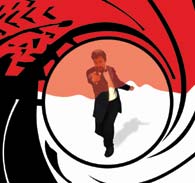 We are inevitably characterized by what we’re into, even as our interests wax and wane. My particular pleasure: Bond. James Bond. The second movie I ever saw in a theater was The Spy Who Loved Me (the first was Star Wars, natch). It was in Montreal, and I was tired after a day of sightseeing, so my parents had to literally drag me to the cinema. After the movie, we went to a local diner for a late snack, and the entire time we were there, I was humming the James Bond theme — over and over. In other words, life-changing influence, to the point where I foolishly avoided the Beatles for years, based on a single quip by Sean Connery: “My dear, there are some things that just aren’t done — such as drinking a Dom Perignon ’53 above a temperature of 38 degrees Fahrenheit. That’s almost as bad as listening to the Beatles without earmuffs.”
We are inevitably characterized by what we’re into, even as our interests wax and wane. My particular pleasure: Bond. James Bond. The second movie I ever saw in a theater was The Spy Who Loved Me (the first was Star Wars, natch). It was in Montreal, and I was tired after a day of sightseeing, so my parents had to literally drag me to the cinema. After the movie, we went to a local diner for a late snack, and the entire time we were there, I was humming the James Bond theme — over and over. In other words, life-changing influence, to the point where I foolishly avoided the Beatles for years, based on a single quip by Sean Connery: “My dear, there are some things that just aren’t done — such as drinking a Dom Perignon ’53 above a temperature of 38 degrees Fahrenheit. That’s almost as bad as listening to the Beatles without earmuffs.”
But say the words “James Bond” on any hip online discussion board today — try Ain’t It Cool News and MI6 for starters — and you’ll find a host of young critics (i.e., from a generation younger than myself) slagging last week’s selection of Daniel Craig as the latest 007, smugly proclaiming the series dead, dead, dead, far past its sell-by date, prehistoric, a “relic of the Cold War,” irrelevant, on the way out, representative of the aged hipsters who have screwed up the world (ouch!), sabotaged by “clueless moron” producers, just plain NOT. Such commentary (or rather, eulogies) has been spirited, but with a whiff of bitterness behind it, as if these critics are spurned lovers, which indicates to me that double-oh-seven still has a hold on us, no matter how much no one would like to admit it. When Craig was introduced as the sixth official James Bond, it made front-page news with most of the major news sites, even while professional and amateur critics made pooh-poohing noises and spent a great deal of time wringing their hands over something they claimed they didn’t care about.
I can say all this with impunity because I’ve been guilty of it myself. Back in 1991, in fact. I wrote a piece for my college newspaper which declared, “Bond is dead, long live Bond.” See, it’s easy to fall into that sagely pessimistic mode. Of course, back then I had a better case to proclaim Bond finished, as United Artists was virtually insolvent, the public had taken to Timothy Dalton like a snake takes to the mongoose (and this is coming from a man who actually liked good old Timothy), and no plans for anything were forthcoming. Compared to that, the introduction of the hugely unpopular (if you believe the CNN poll) Daniel Craig seems like a mere hiccup.
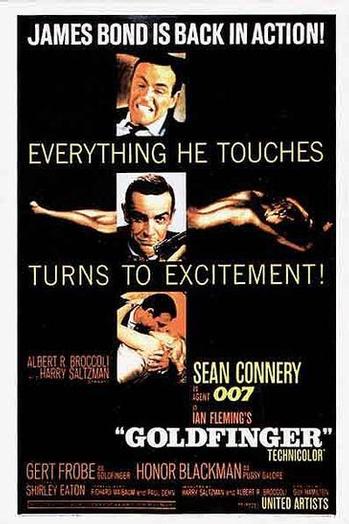 Like most popular phenomena, Bond is more than what he is. As he has been co-opted by the world, he has morphed within the eyes of his beholders, and as with most things that belong to everyone, no one can agree on what actually constitutes Bond. Certainly some aspects are pure bottom line: tall, dark, handsome Englishmen, license to kill, vodka martini, gadgets, lovely ladies, etcetera. But on reviewing the film series, it’s remarkable to see how pliable the concept is. For those who enjoy camp or sniggering one-liners galore, look no further than the near-classic blaxploitation of Live and Let Die, or the not-so-classic “jump on the Star Wars bandwagon” regurgitations of Moonraker. Straight spy thriller aficionados can treasure From Russia with Love. For epic locales, slackening plots, and jaw-dropping set pieces, check out You Only Live Twice or The Spy Who Loved Me. For everything wrapped into one neat package, see Goldfinger. Or for a flawed masterpiece that manages to deconstruct what Bond is about, even as it dutifully fulfills all the formulaic requirements, there’s On Her Majesty’s Secret Service.
Like most popular phenomena, Bond is more than what he is. As he has been co-opted by the world, he has morphed within the eyes of his beholders, and as with most things that belong to everyone, no one can agree on what actually constitutes Bond. Certainly some aspects are pure bottom line: tall, dark, handsome Englishmen, license to kill, vodka martini, gadgets, lovely ladies, etcetera. But on reviewing the film series, it’s remarkable to see how pliable the concept is. For those who enjoy camp or sniggering one-liners galore, look no further than the near-classic blaxploitation of Live and Let Die, or the not-so-classic “jump on the Star Wars bandwagon” regurgitations of Moonraker. Straight spy thriller aficionados can treasure From Russia with Love. For epic locales, slackening plots, and jaw-dropping set pieces, check out You Only Live Twice or The Spy Who Loved Me. For everything wrapped into one neat package, see Goldfinger. Or for a flawed masterpiece that manages to deconstruct what Bond is about, even as it dutifully fulfills all the formulaic requirements, there’s On Her Majesty’s Secret Service.
This pliability is the Bond series’ secret weapon. While other genre entertainments calcify within a few entries, 007 continually reinvents himself, acknowledging the end of Cold Wars with a throwaway line, or welcoming disco with an insousciant wink. The gadgets stay blissfully outrageous (everyone groaned at the invisible car in Die Another Day, but no one will blink when it becomes a reality ten years from now), the exotic locales give way to the latest global hot spots, and even the man himself is redefined with each actor who plays him. But through these myriad transformations, the general structure of things stays the same — the briefing by cantankerous ‘M’ (Bernard Lee and Judi Dench may seem worlds apart, but they both share a rough affection for their Bonds), a globe-threatening villain, a hair-raising escape or chase (by land, sea, or air, take your pick), a closing clinch with the heroine. The successful Bond films manage to reflect the current Zeitgeist without giving in to it, or turning it into cheap homage. Thus, yesterday’s glamorous terrorist organization becomes today’s media baron megalomaniac, to tomorrow’s renegade North Korean general. Like throwing together a jury-rigged vehicle, the Bond filmmakers have become adept at switching out parts on the run and injecting customization when needed. When something works (crazy stunt scene for the pre-title credits), keep it; when it doesn’t (shrieking damsels in distress — hello, Tanya Roberts), throw it out.
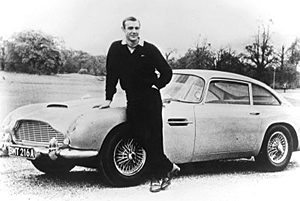 We appreciate the familiarity of these Noh-like affairs (thanks to Richard Shickel for the analogy), because we appreciate the formula, and take our pleasures (or disappointments) from how it’s toyed with. At their best, the Bond films make you feel pleased with yourself as you glide down the tracks of smooth genre formality — and then they quicken your heartbeat when they throw in a few roadblocks. The beauty of it is that like the best fast food, one can pick a favorite Bond (movie, actor, whatever) like a favorite sandwich. Perhaps one’s preference lies in the elegant yet brutal stylings of director Terence Young (don’t fall prey to the common misperception that Bond movies are solely producer-driven — all of the directors have brought their stamp to bear on the legend, with wildly varying degrees of success). Or if fantastic vistas and clashing armies are your cup of tea, browse Lewis Gilbert’s catalogue. Or if sprightly, meticulously shot action scenes are the ticket, check out John Glen. And so on, and so forth.
We appreciate the familiarity of these Noh-like affairs (thanks to Richard Shickel for the analogy), because we appreciate the formula, and take our pleasures (or disappointments) from how it’s toyed with. At their best, the Bond films make you feel pleased with yourself as you glide down the tracks of smooth genre formality — and then they quicken your heartbeat when they throw in a few roadblocks. The beauty of it is that like the best fast food, one can pick a favorite Bond (movie, actor, whatever) like a favorite sandwich. Perhaps one’s preference lies in the elegant yet brutal stylings of director Terence Young (don’t fall prey to the common misperception that Bond movies are solely producer-driven — all of the directors have brought their stamp to bear on the legend, with wildly varying degrees of success). Or if fantastic vistas and clashing armies are your cup of tea, browse Lewis Gilbert’s catalogue. Or if sprightly, meticulously shot action scenes are the ticket, check out John Glen. And so on, and so forth.
To be fair, Bond hasn’t been culturally indispensible since the 60s. Back in his heyday, his influence was widespread: these were the event movies of their time (just adjust some of those box office numbers for inflation, and you’ll see), and introduced elements that have seeped into every genre film since: soundtracks based on rousing theme songs and stirring melodies (eternal thanks to John Barry), a zippier approach to film editing (courtesy of editor Peter Hunt), and an infatuation with the accoutrements of sophistication, whether that be on the technical side of things (where Tom Clancy, 24, and their high-geek brethren live), or simply living the illicit good life (caper movies, or fleet-footed thrillers with deceit and misdirection as their virtues). Those who say that Bond is no longer relevant have to sit up and pay attention when Peter Jackson notes that the beginning of The Fellowship of the Ring is based on the pre-title “teaser” structure of a Bond film, or when the urbane Bruce Wayne (Christian Bale) gets flirty with his secretary in Batman Begins — shades of Moneypenny, there — before popping down to the lab to snap up the latest gadgets from “Q,” er, I mean Lucius Fox (Morgan Freeman). When talents as disparate as Spike Lee, Quentin Tarantino, and Vartan Gregorian all pledge their undying love for 007, it’s clear that Bond still exists, even if the series that spawned him isn’t aware of it.
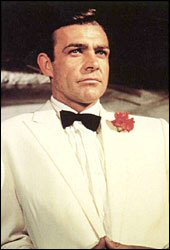 Actually, the Bond series hit its apex with On Her Majesty’s Secret Service (1969). As Charles Taylor’s excellent Salon essay notes, the movie ends the story of James Bond with a brave, downbeat flourish. Having pinned themselves in that artistic corner, there was nothing left for the producers to do but retell the same stories, starting with Sean Connery’s last hurrah in Diamonds Are Forever (1971). In general, Connery casts a gigantic shadow over the series, and his performances reflect the unusual contrasts that define it. The son of a truck driver, a rough-and-tumble Scot who has MOTHER tattooed on his forearm, he would be the last person you would expect as a gentleman spy and killer, but in a rare kind of alchemy, the role smoothed out his rough edges, while he gave the part bite and earthiness that established a new kind of action hero. Everyone from Harrison Ford to Bruce Willis has followed in Connery’s everyman footsteps, without quite duplicating the sexual magnetism and coiled sense of danger that exemplified him at his peak.
Actually, the Bond series hit its apex with On Her Majesty’s Secret Service (1969). As Charles Taylor’s excellent Salon essay notes, the movie ends the story of James Bond with a brave, downbeat flourish. Having pinned themselves in that artistic corner, there was nothing left for the producers to do but retell the same stories, starting with Sean Connery’s last hurrah in Diamonds Are Forever (1971). In general, Connery casts a gigantic shadow over the series, and his performances reflect the unusual contrasts that define it. The son of a truck driver, a rough-and-tumble Scot who has MOTHER tattooed on his forearm, he would be the last person you would expect as a gentleman spy and killer, but in a rare kind of alchemy, the role smoothed out his rough edges, while he gave the part bite and earthiness that established a new kind of action hero. Everyone from Harrison Ford to Bruce Willis has followed in Connery’s everyman footsteps, without quite duplicating the sexual magnetism and coiled sense of danger that exemplified him at his peak.
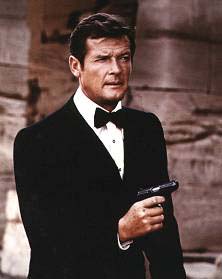 Since Connery’s departure, the series has settled into a ragged collection of pretty-good and pretty-bad entries, nothing teeth-grindingly awful (A View to a Kill notwithstanding), but few moments stick to the memory. Roger Moore was an able successor, bending the part so it fit his own polished, light-as-cream custard image, and it was during his tenure that Bond films became entertainments, much like amusement park rides — the thrills were there, but the surprises were diminished. Sensing ennui, the producers made the gutty choice of bringing in Dalton, who appeared in one above-average entry, The Living Daylights, and then nosedived in License to Kill. Most Ian Fleming fans will tell you that the earnest Dalton has been the most accurate representation of literary Bond on the big screen to date; this may be true, but the filmmakers cannily recognized early on that the Bond of the novels is a bit of a stiff — who else would spend whole paragraphs reflecting on the proper way to cook eggs in the morning? In order to make the whole shebang work, Bond needed self-awareness, an ability to chuckle at the flamboyant villains and his pulpy predicaments. And so we have Connery smirk at Dr. No in his very first film: “World domination, same old dream.” One thing is for sure — Fleming would have flung cigarette ash on the bones of License to Kill with utter distaste. The purists may argue that it brings back the grit and violence of the best Fleming novels, but Fleming would never have gone for something so desultory, so unglamorous, as dope smugglers in Mexico hiding behind the auspices of Wayne Newton(!) as a television preacher. Without the taste for elegant perversity that Fleming brought to even his toughest tales, License to Kill blunders into Miami Vice territory — only not half as fun.
Since Connery’s departure, the series has settled into a ragged collection of pretty-good and pretty-bad entries, nothing teeth-grindingly awful (A View to a Kill notwithstanding), but few moments stick to the memory. Roger Moore was an able successor, bending the part so it fit his own polished, light-as-cream custard image, and it was during his tenure that Bond films became entertainments, much like amusement park rides — the thrills were there, but the surprises were diminished. Sensing ennui, the producers made the gutty choice of bringing in Dalton, who appeared in one above-average entry, The Living Daylights, and then nosedived in License to Kill. Most Ian Fleming fans will tell you that the earnest Dalton has been the most accurate representation of literary Bond on the big screen to date; this may be true, but the filmmakers cannily recognized early on that the Bond of the novels is a bit of a stiff — who else would spend whole paragraphs reflecting on the proper way to cook eggs in the morning? In order to make the whole shebang work, Bond needed self-awareness, an ability to chuckle at the flamboyant villains and his pulpy predicaments. And so we have Connery smirk at Dr. No in his very first film: “World domination, same old dream.” One thing is for sure — Fleming would have flung cigarette ash on the bones of License to Kill with utter distaste. The purists may argue that it brings back the grit and violence of the best Fleming novels, but Fleming would never have gone for something so desultory, so unglamorous, as dope smugglers in Mexico hiding behind the auspices of Wayne Newton(!) as a television preacher. Without the taste for elegant perversity that Fleming brought to even his toughest tales, License to Kill blunders into Miami Vice territory — only not half as fun.
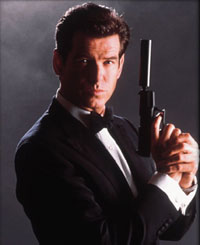 With misfires like that, it’s no wonder that most question Bond’s relevance in today’s world. Yet something must still be working (that is, if you’re not cynical enough to believe that the box office-busting performances of the past few Bonds are solely attributable to marketing hype). Is that something Pierce Brosnan, who is generally acknowledged as the second best Bond behind Connery? If you compare the Brosnan Bonds to latter-day Moore or even Dalton, they seem positively professional, but their polish fails to conceal a tired, generic air about them. In keeping with that finicky Zeitgeist, Bond films are now more about the motion than the meat — throw together some lumbering action sequences set to David Arnold’s cut-and-paste techno symphonies, add explosions for good measure, follow the formula, the end. To his credit, Brosnan essayed a more psychologically complex 007 in his films, and his last two entries, The World Is Not Enough and Die Another Day, contain some of the most Bondian passages since Connery, although wading through the clamor and clatter of these movies, with their needlessly murky plots and slatherings of special effects, to make it to these moments is like seeking the proverbial oasis in the desert. And although he was superficially perfect for the role, as if minted for it, Brosnan was never entirely comfortable as 007. Tossing puns with the enthusiasm of a wooden soldier, squinting and setting his jaw, sometimes dwarfed by the mayhem around him, he was strangely reticent at times, lacking the avuncular charm of Moore or the all-out charisma of Connery.
With misfires like that, it’s no wonder that most question Bond’s relevance in today’s world. Yet something must still be working (that is, if you’re not cynical enough to believe that the box office-busting performances of the past few Bonds are solely attributable to marketing hype). Is that something Pierce Brosnan, who is generally acknowledged as the second best Bond behind Connery? If you compare the Brosnan Bonds to latter-day Moore or even Dalton, they seem positively professional, but their polish fails to conceal a tired, generic air about them. In keeping with that finicky Zeitgeist, Bond films are now more about the motion than the meat — throw together some lumbering action sequences set to David Arnold’s cut-and-paste techno symphonies, add explosions for good measure, follow the formula, the end. To his credit, Brosnan essayed a more psychologically complex 007 in his films, and his last two entries, The World Is Not Enough and Die Another Day, contain some of the most Bondian passages since Connery, although wading through the clamor and clatter of these movies, with their needlessly murky plots and slatherings of special effects, to make it to these moments is like seeking the proverbial oasis in the desert. And although he was superficially perfect for the role, as if minted for it, Brosnan was never entirely comfortable as 007. Tossing puns with the enthusiasm of a wooden soldier, squinting and setting his jaw, sometimes dwarfed by the mayhem around him, he was strangely reticent at times, lacking the avuncular charm of Moore or the all-out charisma of Connery.
So what maintains our interest despite these letdowns? It’s an answer as old as storytelling itself — the pleasure of a tale well told, even if it’s been told countless times before. Just as we teeter at the edge of familiarity and unpredictability with everything we encounter in life, we ride that edge with every new Bond film. Will it satisfy our expectations, and give us something new? As David Arnold has noted, the first ten seconds of a Bond film are always the most anticipatory and exciting, because it is in those ten seconds that we are allowed to think: This could be the best Bond film ever. And even if the overwhelming majority of the movies fail to deliver on that expectation, they draw us in deep enough to bring us back — whether it’s the impossibly beautiful women who are brainy enough to stand on their own but feminine enough to succumb to Bond’s wiles, the kid-on-Christmas-morning glee of his gadgets, or the swinging, uncomplicated masculinity of Bond himself. Or to put it even more simply, it’s wish fulfillment at its finest, as producer Albert “Cubby” Broccoli once said: Men want to be him, and women want to be with him.
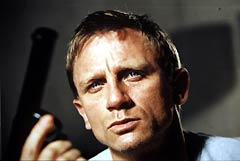 Fittingly enough, that leads us to the latest injection of unpredictability into the Bond franchise: Daniel Craig. A relatively unknown actor, brooding in a British Steve McQueen kind of way, he’s nowhere near as chiseled or handsome as Brosnan, and marks a startling departure — he’s blond, for heaven’s sake. Already the producers and writers are commenting about the next opus, Casino Royale, based on Fleming’s first Bond novel, and how it will be a “reboot,” or Bond Begins, if you will. More character, more story, less emphasis on endless action, etcetera. We can be forgiven for being skeptical about this — if the series is starting over, fresh and invigorated, then what is a mediocrity like Martin Campbell (who helmed the lugubrious Goldeneye) doing anywhere near this project? Why are Neal Purvis and Robert Wade (the culprits behind the uninspired puns and messy plots of the previous two films) scripting this? Perhaps the critics really have it right this time — with the usual plodding talents behind the camera, coupled with a choice of Bond that seems to have resulted in a resounding “meh” from the media and public, Casino Royale may turn out to be the moment when Bond finally comes face-to-face with his own irrelevance — and loses.
Fittingly enough, that leads us to the latest injection of unpredictability into the Bond franchise: Daniel Craig. A relatively unknown actor, brooding in a British Steve McQueen kind of way, he’s nowhere near as chiseled or handsome as Brosnan, and marks a startling departure — he’s blond, for heaven’s sake. Already the producers and writers are commenting about the next opus, Casino Royale, based on Fleming’s first Bond novel, and how it will be a “reboot,” or Bond Begins, if you will. More character, more story, less emphasis on endless action, etcetera. We can be forgiven for being skeptical about this — if the series is starting over, fresh and invigorated, then what is a mediocrity like Martin Campbell (who helmed the lugubrious Goldeneye) doing anywhere near this project? Why are Neal Purvis and Robert Wade (the culprits behind the uninspired puns and messy plots of the previous two films) scripting this? Perhaps the critics really have it right this time — with the usual plodding talents behind the camera, coupled with a choice of Bond that seems to have resulted in a resounding “meh” from the media and public, Casino Royale may turn out to be the moment when Bond finally comes face-to-face with his own irrelevance — and loses.
 More likely, though, is that we will witness another regeneration. Having viewed Craig in Layer Cake recently, there’s no doubt that he’s a fine actor. Layer Cake (or as it’s actually spelled, L4yer Cak3) is no masterpiece, deploying the same Brit gangster formulas we’ve seen since Lock, Stock, and Two Smoking Barrels, and despite Matthew Vaughn’s efficient direction, it never finds its rhythm. But Craig is fascinating, easily flitting between cool-cat calm, fumbling uncertainty, outright panic, and back again. He may not be anyone’s idea of Bond, but that might be to his advantage as he reinvents the character. Casino Royale won’t recapture the good old days — no cultural phenomenon could ever recapture the time and circumstances of its birth — but if we’re lucky, it’ll be a bit of much needed resuscitation which will keep this jury-rigged vehicle going for a few more entries, or at least until the next renovation. And having grown up with it, I’m not ashamed to say that this is my jury-rigged vehicle. ■
More likely, though, is that we will witness another regeneration. Having viewed Craig in Layer Cake recently, there’s no doubt that he’s a fine actor. Layer Cake (or as it’s actually spelled, L4yer Cak3) is no masterpiece, deploying the same Brit gangster formulas we’ve seen since Lock, Stock, and Two Smoking Barrels, and despite Matthew Vaughn’s efficient direction, it never finds its rhythm. But Craig is fascinating, easily flitting between cool-cat calm, fumbling uncertainty, outright panic, and back again. He may not be anyone’s idea of Bond, but that might be to his advantage as he reinvents the character. Casino Royale won’t recapture the good old days — no cultural phenomenon could ever recapture the time and circumstances of its birth — but if we’re lucky, it’ll be a bit of much needed resuscitation which will keep this jury-rigged vehicle going for a few more entries, or at least until the next renovation. And having grown up with it, I’m not ashamed to say that this is my jury-rigged vehicle. ■


Comments
Jonathan David Jackson
I can assure you that I have nothing to auction; nor do I need you to work at home. Ho: this is by far your […] Read MoreI can assure you that I have nothing to auction; nor do I need you to work at home. Ho: this is by far your best, most audacious, critical-cum-personal commentary on genre flicks yet! I mean, you laid out everything with visuals too (and, of course, the last visual of the time when the role of JB went to this CA film critic, film-maker, editor, and fiction writer was the best of all because a lot of people don't know that this guy had the role). I'm home early from work because I caught the gastroninti(whatever) virus of my students. So I'm watch the feyest (that's a good thing) flick starring Gene Kelly called "Les Girls." Read Less
Anonymous
I'm having a strange auction your house but I need someone to come there and work for 10-50 dollars an hour to clean it up. […] Read MoreI'm having a strange auction your house but I need someone to come there and work for 10-50 dollars an hour to clean it up. Who was that last bond? I hope for Ian Fleming's sake he's not Korean! Read Less